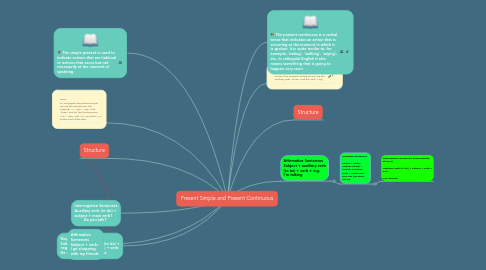Present Simple and Present Continuous
por Alexander Gonzalez


1. Interrogative Sentences Auxiliary verb (to do) + subject + main verb? Do you talk?
2. Negative Sentences Subject + auxiliary verb (to do) + negative auxiliary ("not") + verb He does not [doesn’t] eat.
3. Affirmative Sentences Subject + verb : I go shopping with my friends
4. Form: To conjugate the present simple we use the infinitive for the subjects "I", "you", "we" and "they" and for the third persons "he", "she" and "it", we add a "-s" to the end of the verb.
5. The simple present is used to indicate actions that are habitual or actions that occur but not necessarily at the moment of speaking
6. Structure
7. Form: To form the present continuous we use the auxiliary verb "to be" and the verb + ing
8. Affirmative Sentences Subject + auxiliary verb (to be) + verb + ing. I’m talking
8.1. Negative Sentences Sujeto + verbo auxiliar (to be) + auxiliar negativo (not) + verbo+ing He’s not [He isn’t] eating
8.1.1. Interrogative Sentences (Interrogative phrases) Auxiliary verb (to be) + subject + verb + ing? Is it raining?
